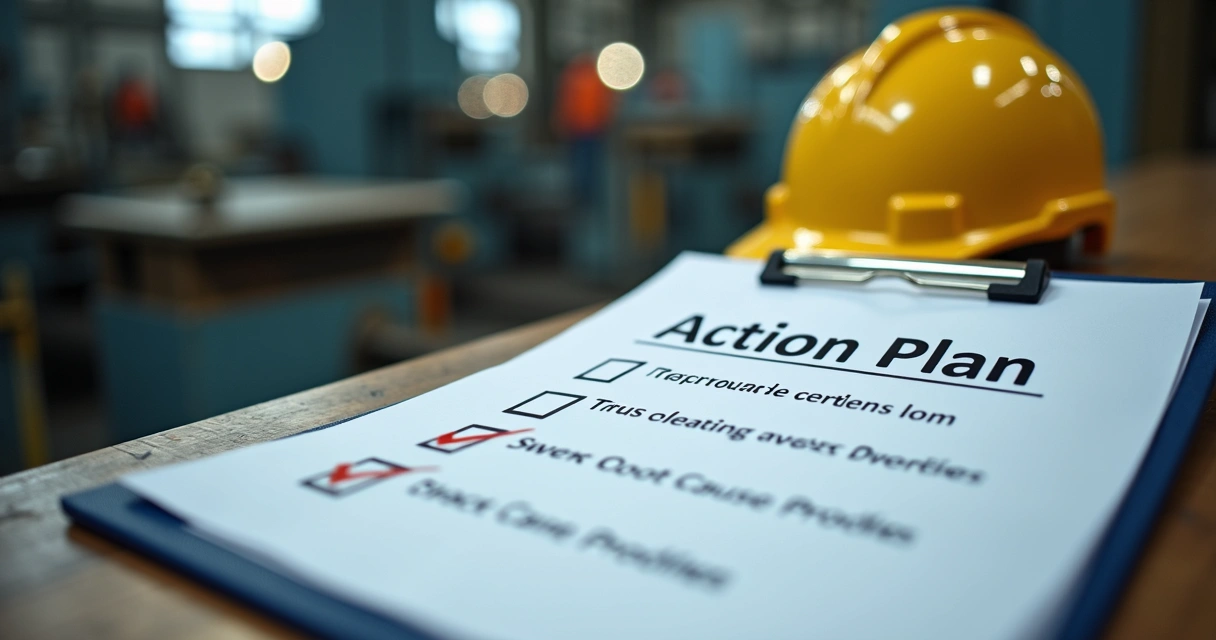Root Cause Analysis (RCA): A Practical Guide for Industrial Teams

Almost every industrial place faces some failure, breakdown, or quality issue. Sometimes it’s dramatic—a sudden line stoppage. Other times, it’s more subtle: little flaws that add up, chipping away at trust, safety, or performance. Whatever the form, underneath each problem lies a cause. Sometimes, even a tangle of them. And if you find it—the true driving force—you can solve far more than just the immediate trouble.
This is the heart of root cause analysis, or RCA. It’s not a buzzword or just a one-off report; it’s a practical toolkit for disciplined problem-solving and long-term improvement. Think of it as the detective work behind a safer, more reliable, and more competitive operation. In this guide, we explore not just the “what” of RCA, but the “how” and, maybe more importantly, the “why it matters.” Along this path, you’ll see how platforms like Prelix make RCA more accessible, faster, and consistent—even as complexity grows.
The concept of root cause analysis and why it matters
People often say, “treat the cause, not just the symptom.” Root cause analysis brings that idea to life. Put simply, RCA is a structured process for identifying what really lies behind a problem or failure, rather than just patching the side effects. It’s the difference between plugging a leak and rebuilding the pipe so it won’t burst again.
But why spend time chasing the deeper cause? Because most industrial issues repeat. Fixing only the obvious can mean the same trouble will return—sometimes disguised, sometimes worse. Getting to the root removes the risk at its source.
There’s another reason: cost and trust. According to quality control research by WIFITalents, manufacturing defects usually come from errors in quality control. Companies that address the source, not just the output, lower their returns and rework by around 15%, and almost 60% of them see a lift in customer satisfaction. Cut the cause—costs fall, trust rises.
Solve the cause, not just the effect.
At its best, root cause analysis isn’t just a tool for crisis response—it supports a daily mindset of improvement, learning, and prevention. It’s the backbone for not only avoiding downtime and boosting safety, but building a culture where people want to fix what really matters.
Common techniques to find the real causes
Over the years, different industries have developed a range of RCA tools and frameworks. Some are simple enough for quick fixes, others suit big investigations or complex systems. Here are the main ones you’ll encounter:
The five whys
It’s as straightforward as it sounds. Start with the problem, ask “why?” to the answer, five times (give or take), digging each time for a cause closer to the root. For instance, if a motor fails:
- Why did the motor stop? — It overheated.
- Why did it overheat? — The cooling fan stopped.
- Why did the fan stop? — Voltage dropped to the fan motor.
- Why did voltage drop? — The breaker tripped.
- Why did the breaker trip? — The insulation was worn out.
This method is good for everyday issues and works best if you’re honest and avoid blame. Don’t settle for the first answer—keep digging, or you might miss the real culprit.
Fishbone diagram (ishikawa)
Visually, it looks like a fish skeleton. The head is the problem, the “bones” are categories of potential causes: Methods, Machines, Materials, Measurements, People, and Environment. Teams brainstorm and sort out likely causes in each group, helping everyone see connections rather than just guessing.
This tool is especially useful when the cause isn’t obvious, or when problems come from several sources at once. By writing things down, people see patterns or links that talking alone might miss.
FMEA – failure modes and effects analysis
If you want to predict what could fail, rather than just explain what did, FMEA is your friend. It’s a systematic way of spotting possible failure modes (the different ways parts or steps could go wrong), what effects those might have, and how likely/severe they are.
In FMEA, you score each risk for its frequency, severity, and detectability. The highest scores show what to tackle first. You’ll see this tool in design engineering, maintenance planning, and anywhere prevention matters.
Process mapping
Sometimes, the problem isn’t one event or piece—it’s how a whole sequence unfolds. Mapping out the process, step by step, surfaces where delays, errors, or confusion seep in. When teams look at the full flow, they spot bottlenecks, unnecessary steps, or places where information gets lost. Often, fixes become obvious only after laying out all the steps in plain view.
 Used together, these tools let teams stop guessing and start connecting evidence, logic, and teamwork. Each technique fits different problems—you might try one, or a mix, as the situation needs.
Used together, these tools let teams stop guessing and start connecting evidence, logic, and teamwork. Each technique fits different problems—you might try one, or a mix, as the situation needs.
Good data makes all the difference
Imagine tracking a process with only vague memories, or secondhand stories from the shop floor. That’s a recipe for missed causes and false solutions. Solid RCA depends on clear, reliable data:
- Machine readings
- Logbooks and sensors
- Maintenance and inspection records
- Operator or technician interviews
- Pictures, videos, or samples
Research from the Manufacturing Enterprise Solutions Association (MESA), described in this analysis of manufacturing analytics, highlights that projects with defined objectives and focus on a few key parameters—not just “everything”—wind up far more successful.
Yet, even with all this information, data alone rarely tells the full story. People’s experience, perspective, and sometimes hunches, play a role. It’s the combination—hard facts and human insight—that unlocks what’s really going on.
Why collaboration matters
In most cases, the real cause is hidden in the overlap between jobs or departments. Maintenance, production, logistics—all have a piece of the puzzle. If the analysis is locked away with just one team or one expert, you risk missing vital clues.
Instead, bring together those who know the equipment, use the process, and handle the aftermath. Open discussion uncovers not just what went wrong technically, but what broke down in communication, training, or hand-over. Prelix, for example, helps with shared digital workspaces and real-time reports, keeping everyone in the loop easily and cut to the chase.
The practical steps of an effective RCA
Every RCA framework—no matter how fancy—rests on a handful of key actions:
- Define the problem. Be precise. “The machine broke” is vague. “Packaging line halted at station 3 due to a jam in the cutter assembly” tells you where to start.
- Collect the facts. Get the who, what, when, where, and how often. Pull logs, review drawings, interview witnesses.
- Map the sequence. Use diagrams, flowcharts, or lists. Clarify what happened before, during, and after the problem.
- Find potential causes. Brainstorm, but don’t judge—just list. Use “five whys” or a fishbone diagram if it helps.
- Test each cause. Ask yourself, “If this was the cause, would it explain all the facts?” Check with data where you can.
- Pin down the root causes. Often, more than one thing went wrong. Find all, not just one.
- Plan corrective actions. What must change to stop it happening again? (Sometimes, that’s a process, training, or system update, not just fixing a broken part.)
- Check if the fix works. Monitor for signs the trouble comes back. Create a loop where future mishaps trigger a review, not finger-pointing.
According to studies on root cause analysis in operations, using RCA can cut recurring issues by up to 50% and save considerable costs—up to 30% from slashed waste and unplanned downtime. It’s not magic. It’s about clear steps, careful attention, and discipline to see it through, even when time is tight.
 How RCA looks in day-to-day industry
How RCA looks in day-to-day industry
It’s tempting to believe root cause work is something for big disasters—a conveyor fire, a major injury, a lost customer worth millions. But, more often, the biggest wins come from applying the approach daily, even to the small stuff. Here’s where it changes the game:
- Maintenance teams spot patterns in recurring breakdowns, quickly moving from replacing the same part again and again to fixing what’s really wrong—be it lubrication routines or design tweaks.
- Quality control detects that a handful of small variances have a shared source, letting teams deliver more consistent products and stop defects before they hit the customer. That’s in line with findings from WIFITalents’ global quality statistics, showing that rigorous systems reduce returns and improve satisfaction for the majority of companies.
- Process engineers use FMEA to anticipate where failures might lurk as they roll out new machinery or automation, so glitches get fixed before startup ever happens.
- Management leans on RCA reports to decide what to invest in next—be it better training, new tools, or major process changes.
The same approach drives improvement in nearly every sector—not just factories, but warehouses, utilities, hospitals, and beyond. It brings stability, safety, and even competitive advantage. According to WorldMetrics’ research on problem-solving, companies using structured root cause analysis report up to 69% higher satisfaction and fix half as many repeat issues compared to their peers.
The benefit comes not just in the big, infrequent fixes, but in making every team just a little bit sharper, quicker, and more confident with each small problem they handle.
The role of corrective actions and ongoing monitoring
Even the slickest RCA fails if the insight stays on paper. Taking action is what makes all the investigation worth it. Real change often involves more than swapping a part or tightening a connection—it can mean adjusting schedules, updating training, or even changing how decisions are made.
But how do you know the fix worked? It’s about building feedback in—the kind of cycle closed-loop control systems achieve, which, as found in recent industrial studies, let companies respond to anomalies 27 times faster than manual systems.
- Set checkpoints or audits for the fix.
- Track incidents or near-misses after changes.
- Have teams review what’s working or if tweaks are needed—without blame.
Monitoring is important not just for the sake of catching failures, but to build trust that problems are really solved and to learn for the next challenge. And when systems (like Prelix) automate that follow-up, teams are free to focus on deeper improvements, not just firefighting.
Bringing in technology and visual tools
In the old days, much of RCA lived on paper charts or whiteboards. But as systems grow more complex and data volumes explode, old methods struggle to keep up. Now, technology plays a starring role.
For instance, digital platforms—such as Prelix—let teams instantly generate diagrams, track history, and report outcomes in formats tailored for compliance. They can pull data directly from connected machines, reducing errors from missed readings or manual entry.
 And there’s more: recent analysis of AI in root cause analysis found that artificial intelligence can spot subtle patterns missed by even the sharpest engineers—cross-checking thousands of variables in minutes, not weeks. AI is helping teams predict trouble, not just react to it, and quickly surface which changes make the biggest impact.
And there’s more: recent analysis of AI in root cause analysis found that artificial intelligence can spot subtle patterns missed by even the sharpest engineers—cross-checking thousands of variables in minutes, not weeks. AI is helping teams predict trouble, not just react to it, and quickly surface which changes make the biggest impact.
Visualization matters too. A well-crafted fishbone or process map can spark understanding (and debate) in ways written pages can’t. These tools help align everyone’s understanding and make action items clear for all to see.
Encouraging a culture of prevention and continuous improvement
No process or tool can replace the human side. For RCA to work—really work—teams need psychological safety to admit mistakes, share what they see, and suggest changes, even when it puts cherished routines at risk. This comes only when leaders set the tone by modeling curiosity, transparency, and learning, not blame.
A strong RCA approach is about more than one investigation; it’s a habit of mind. Teams share lessons, adapt procedures, and look for small daily improvements. Celebrating successes, teaching what worked (and what didn’t), and tracking each fix as part of the ongoing story builds momentum.
One thing to keep in mind: even the best organizations stumble. It’s normal to fall back on quick fixes when busy, or to gloss over causes when deadlines loom. But when everyone buys into the value—supported with tools like Prelix, and routines that make good RCA easy—long-term improvement becomes a natural part of the job.
A culture of learning wins over a culture of blame.
Conclusion: moving forward with root cause mindset
Root cause analysis isn’t just about fixing one-off disasters—it’s a way of working that brings calm, confidence, and growth to every industrial team. When you make RCA part of your routine, problems become learning opportunities, and even the toughest failures become launch pads for progress.
Critical steps—understanding the issue, gathering good data, collaborating across teams, using the right analytical tools, and following through to corrective action—transform daily challenges into measurable, repeatable wins. Pull in the right technology, from easy visualization to AI-driven insights, and your team gains precious time and clarity.
If your operation needs faster problem resolution, smarter prevention, or simply wants to learn from every hiccup, take a closer look at the possibilities with solutions like Prelix. Simplify the hard parts, focus on what matters, and watch as every problem solved becomes a new foundation for future reliability. Start putting root cause thinking at the heart of your team—and see how far you can go.
Ready to build a stronger operation? Get to know Prelix and discover how AI-driven RCA can help your team solve problems faster, prevent repeat issues, and turn every failure into the start of something better.
Frequently asked questions
What is root cause analysis in industry?
Root cause analysis in industry is a structured approach to identifying the fundamental reason or source behind a failure, defect, or unwanted event. The aim is to find and address the deepest factor, rather than just fixing symptoms. In industrial settings, it means uncovering the technical, process, or human cause behind breakdowns, product flaws, or safety incidents, so problems don’t repeat. This method involves data gathering, team discussion, and tools that track down the cause, as described throughout this article.
How to perform an effective RCA?
To carry out an effective RCA, start by clearly defining the problem with as much detail as possible. Gather evidence through machine data, logs, and eyewitness accounts. Map the timeline or process flow to organize the facts. Use brainstorming or analytical tools like five whys, fishbone diagrams, or FMEA to list potential root causes. Test each likely cause to ensure it fits all the evidence. Find the underlying causes—there might be more than one. Plan what steps (corrective actions) are needed to fix the cause at its source. Finally, monitor the fix to confirm it prevents repeat incidents. Teamwork and open communication help the process work better and prevent bias.
What are the main steps of RCA?
The fundamental steps are:
- Define the problem in clear terms
- Collect relevant data and evidence
- Map out the timeline or process sequence
- Brainstorm possible contributing factors
- Use analysis methods (like five whys or fishbone diagrams) to track down possible root causes
- Test each cause against the facts
- Identify true root causes (often several)
- Decide on corrective and preventive actions
- Follow up to monitor if the solution was effective
These steps help ensure the issue is solved at its source, rather than just patching symptoms temporarily.Why use RCA in industrial teams?
Industrial teams turn to root cause analysis because it helps solve recurring problems, reduce waste and downtime, improve product or service quality, prevent safety incidents, and avoid unnecessary costs. According to studies referenced earlier in this guide, companies that regularly use RCA reduce repeat issues by half, enjoy significant savings, and see higher customer satisfaction by keeping errors from coming back. RCA also boosts learning, teamwork, and confidence across roles—from operators to engineers to managers.
What tools help with RCA analysis?
The most common tools for RCA include five whys, fishbone diagrams (Ishikawa), FMEA, and process mapping. Visual aids like flowcharts or timelines help clarify the sequence of events. Digital platforms, such as Prelix, offer collaborative spaces to store data, create diagrams, auto-generate reports, and even use artificial intelligence to spot deeper connections in the data. New technology means faster, more precise RCAs are now within reach for teams of any size or complexity.
13 Comments
Comments are closed.

[…] what matters for each task. If you’re looking for more depth on root cause breakdowns, the guide for RCA in industrial teams gives practical structuring ideas, […]
[…] your needs get more advanced, explore resources like the RCA (Root Cause Analysis) practical guide. For teams moving toward digital transformation, the AI-powered RCA guide (in English) also helps […]
[…] Generate RCA (root cause analysis) diagrams quickly—see this practical guide for industrial teams […]
[…] For more advice and stories from real maintenance teams, I often recommend checking the Prelix blog or even the practical guides to root cause analysis for industrial teams, such as this in-depth practical guide. […]
[…] about what modern root cause analysis integrated with AI looks like, a great resource is this practical guide for industrial teams and the full AI-based RCA […]
[…] Tools like the “5 Whys” and smart diagrams are meant to break this loop. Prelix brings these into one place, generating a clear map from event to cause, so investigation outpaces guesswork. For practical tips and difference real root cause analysis makes, check out their practical guide for industrial teams. […]
[…] If you want strategies for pushing knowledge up and down your team, try reading this practical root cause analysis guide for industrial teams. […]
[…] can review. That cuts hours from RCA and compliance work. If you want a method you can follow, this RCA practical guide for industrial teams is a good starting point. For teams ready to try AI on RCA, the RCA with AI guide for industrial […]
[…] root cause work and turns failure notes into learning. If you want a deeper take on RCA, see this practical guide to RCA for industrial teams and a companion piece on RCA with AI for industrial teams. For teams reading in Portuguese, there […]
[…] from failure data. When RFID proves that one gasket gets pulled twice as often after a change, your RCA guide for industrial teams and the AI-enhanced RCA guide show you how to turn that signal into action. If your team reads in […]
[…] you want a deeper method, the practical guide to RCA for industrial teams details a step-by-step flow, and the guide to RCA with AI shows how machine inference can speed the […]
[…] hits, your team needs context. A short, shared process helps. If you need a starting point, this practical guide to RCA for industrial teams lays out steps and common traps. There is also a focused guide to AI for RCA that shows how modern […]
[…] tree, and produce a clean report that meets audit needs. If you like a deeper walk-through, see a practical guide to RCA for industrial teams and the companion RCA with AI […]